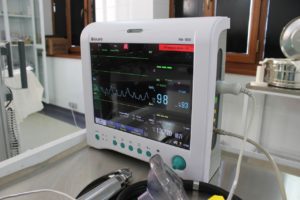
Ever heard biofeedback? It sounds cool, but what does it even mean? If you’re unsure—but desperate to know if biofeedback can help solve your leaky bladder caused by SUI, then this article was designed for you. We’ll cover what biofeedback is and how it can help with stress urinary incontinence.
Biofeedback is not a treatment. Instead, it’s a tool that can help you learn more about your body. As a result, biofeedback can aid in treating certain ailments that require your keen attention.
Officially, biofeedback is: observing and measuring the body’s movements—whether it’s your heart’s beat or another muscle contracting—these are simple examples of body parts often used to provide biofeedback.
Biofeedback is usually done in a therapeutic setting in order to better understand how a patient’s body responds to small changes, particularly when trying to solve a dysfunction. Special instruments are required to measure and record biofeedback, such as a stethoscope, heart monitor, or other specialized equipment. This equipment can record and analyze your biofeedback data for patterns. Additionally, your therapist may help you interpret the live feedback during your session.
Biofeedback sounds great—but what’s it got to do with stress urinary incontinence? Kegels.
Kegels are used to strengthen pelvic floor muscles as a treatment for SUI. Some people struggle to know whether they’ve got the right muscles contracted during Kegels, so that’s why biofeedback can be so helpful for therapists to teach proper techniques.
Biofeedback is used to help patients perform pelvic floor exercises properly, ensuring that the target muscle group is engaged. Special equipment is required, including small sticky sensors that are stuck to the patient’s skin near the nether regions where the pelvic muscles are located.
These sensors are hooked up to a machine that gives the patient feedback in the form of graphs and tones. It can not only tell you instantly whether you’re doing your Kegels right, but it can also measure the strength of your contractions. That means that biofeedback can tell whether your pelvic strengthening program is working over time.
Biofeedback can be more effective than doing Kegels on your own at home for several reasons, including:
Related: The Truth About Kegels: Treating SUI Bladder Leaks
If you’re considering getting biofeedback to help treat your stress urinary incontinence, then you might be wondering what the process entails. First, you’ll need to speak with your doctor to find a therapist who specializes in urinary incontinence and who has biofeedback equipment. You can expect to set up a series of appointments—usually, a handful of appointments are required over a period of a couple of months.
During your appointment, your therapist will help you place your sensors for the biofeedback device and then walk you through different exercises. A screen or audio tones will provide feedback for your therapist to work with you and tell you whether you’re contracting the right pelvic muscles. After your session, you’ll be asked to continue the exercises regularly on your own.
When you return for your next visit, the biofeedback device will be hooked up again, and your therapist will be able to measure your progress from your last visit. This continues until you achieve the desired results. In order to maintain your new muscle tone and relief from SUI, you’ll need to continue a regular strengthening regimen at home.
If you’d rather skip the awkwardness of going to a therapist for pelvic strengthening and biofeedback, there are devices that can provide similar feedback from home. A study found that nearly 7 in 10 patients achieved less bladder leakage after using at-home biofeedback devices for 12 weeks.
If you’re not sure where to start, our doctors at My Virtual Physician are here to help. We’ve worked with many patients who face stress urinary incontinence, and we understand how frustrating it can be when your bladder leaks during laughter, coughing, and exercise. We can counsel you, helping you pick the best course of action; whether it’s working with a professional for biofeedback sessions, trying a pessary such as Uresta, or contemplating surgery—we’re here for you.
Book Appointment Now Call For An Appointment
Schedule your appointment today so that you can get the treatment that gives control of your bladder back to you once again.